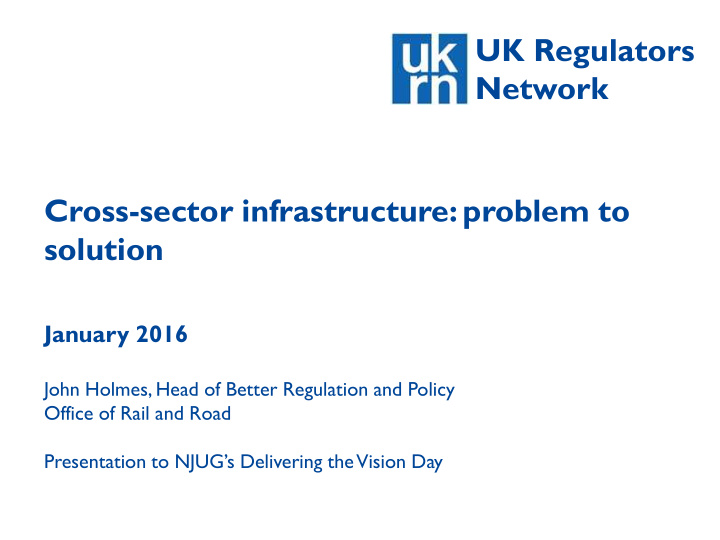



UK Regulators Network Cross-sector infrastructure: problem to solution January 2016 John Holmes, Head of Better Regulation and Policy Office of Rail and Road Presentation to NJUG’s Delivering the Vision Day
Structure of this presentation • Introduce the UK Regulators Network (UKRN): its objective and projects • Explain the problem with ‘cross - sector interactions’ • Why UKRN acted • How we approached this issue • What we found • The solutions we’ve proposed • And, what happens next 2
Who is UKRN? • The UK Regulators Network : members include regulators of utility services, transport, financial, health and legal services • Its objective: promote better regulation and collaboration between regulators, for the benefit of consumers and the wider economy 3
What does UKRN do? • UKRN supports it members through: • A forum to share and learn good regulatory practice • Helping explain regulation to stakeholders • Enabling independent regulators to act jointly or share practices where this is in the interests of consumers • But - UKRN itself is not a regulator: members choose what and how to act in response to UKRN proposals • Projects so far: • Investment focused • Consumer focused • Common cross-sector issues 4
‘Cross - sector interactions’ – the problem • Significant investment – much of it £213 billion on public money – will be spent on utility infrastructure infrastructure by 2021 • Installing new infrastructure can Infrastructure spend by regulated disturb existing in-situ assets of utility utility networks, which need protecting and Water Rail & agreements put in place 15% air 27% • A perception of inefficiency or ‘opportunism’: monopoly networks ‘in Comms Energy the way’ of new development in other 5% 53% sectors Source: HMT and National Infrastructure Pipeline 5
Why UKRN acted • UKRN – independent regulators of key utilities, concerned with two issues: • The impact on regulated networks when they interact with other regulated sectors; and • The impact on the economy , if the behaviour of regulated utility networks raises costs for others • But, what is the evidence and, if appropriate, what should be done, by whom? 6
How we approached this issue: evidence and proportionality June 2014 – industry forum • Evidence – of any harm and its causes – essential to support any action • Broad consultation Call for • We built upon the call for evidence with evidence targeted information requests, meetings with stakeholders and desk research • Many of the responses were confidential or June 2015 – commercially sensitive remedy consultation • Our aim: develop remedies that reduce the costs of infrastructure development, whilst balancing consumers’ and network September operators’ interests 2015 - conclusions 7
What we found The problems in summary: Service Co-ordination Design Costs standards and information standards No clear point Inaccurate asset Onerous Onerous of contact information Specifications contract terms Inconsistent No firm Unco-ordinated Poor cost treatment of timescales access to site transparency similar projects Little adoption Poor governance of best practice 8
The solutions • Three measures: • 5 Good practice principles – a guide to networks and clients • Access statements – the practical information that clients’ need to make crossing assets easier: recommended publication by December 2015 • Annual reporting – a chance to review how well clients’ needs are met, and make improvements • All aimed at supporting a self- regulatory solution 9
What next? Is the problem solved? • Greater cooperation across and between network sectors and infrastructure developers is key to making these solutions a success: something industry, not regulators or government must deliver. • UKRN proposals aim to facilitate greater clarity for clients and promote – not prescribe – action by incumbents • A follow-up review, by UKRN, planned for early 2017: does the problem remain? Were the remedies sufficient? 10
Points of contact • Contact: john.holmes@orr.gsi.gov.uk • UKRN’s website contains copies of all publications and regularly updated news: www.ukrn.org.uk 11
Recommend
More recommend